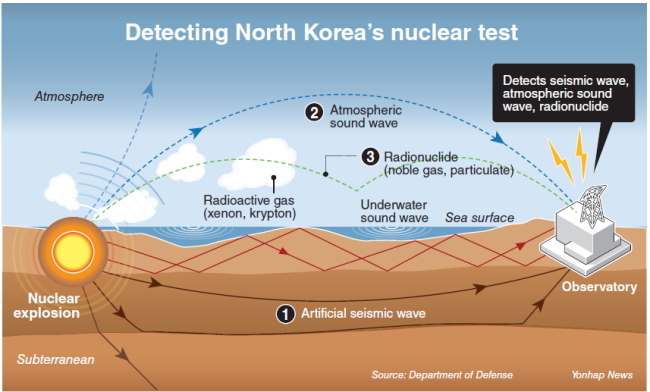North Korea’s nuclear test was detected almost immediately using an extensive network of seismic activity monitoring stations, South Korean authorities said Tuesday.
The Korea Meteorological Administration announced that an artificial earthquake of 4.9 magnitude occurred at 11:57:50 a.m. in Punggye-ri, North Hamgyeong Province ― the location of Pyongyang’s nuclear facility.
Operating a network of 26 seismological observatories across the country, South Korean authorities are able to detect seismic waves generated by nuclear tests within one minute of the detonation.
The location and scale of a nuclear detonation taking place underground are detected and calculated using equipment designed to monitor seismic activity.

As with earthquakes, underground nuclear tests generate two types of shockwaves ― P and S.
Unlike natural earthquakes, however, the fast-moving P-waves are generated first and S-waves are generated later in a nuclear test, allowing the authorities to distinguish between natural and artificially caused seismic waves. In natural earthquakes, both P- and S-waves are generated simultaneously.
Once seismic activity is detected, the data is relayed to the Korea Institute of Geo-science and Mineral Resources, which determines whether the shockwaves were generated by a natural or artificial event.
According to the institute, the seismic waves can be detected initially by the detection facility in northeastern Gangwon Province about 50 seconds after detonation. The institute then analyzes the data in relation to that collected at other facilities to determine the location and scale of the detonation, which requires between 20 and 30 minutes.
Seismic waves, however, are not the only indicators of nuclear tests. A nuclear detonation creates sound waves that are detectable at significant distances, and those generated by a nuclear test in North Korea can be detected by equipment located in South Korea within about 30 minutes.
Although the sound waves generated by nuclear detonations are stronger than those detected in other natural or man-made events, the waves are said to be indistinguishable from sound waves generated by a number of other events such as volcano eruptions, typhoons and rockets.
While seismic and sound waves are used to determine the location and scale of a nuclear test, radioactive materials released from the test are used to determine whether uranium or plutonium was used in the explosive device.
When a nuclear device is detonated, radioactive isotopes of various elements are released into the surroundings.
For South Korea to identify the material used in North Korea’s latest nuclear test, radioactive isotopes of elements such as xenon and krypton need to be detected.
While South Korea’s nuclear authorities operate the necessary facilities, the identification process may be hampered by the changes Pyongyang has made to its test facility since the first nuclear test in 2006.
The 2006 test was conducted in an underground facility with straight shafts, which allowed radiation and radioactive materials to escape.
According to the Ministry of National Defense, however, Pyongyang built a winding shaft with 10 doors that close and prevent leakages for the second test in 2009, which blocked radiation from reaching the outside.
By Choi He-suk (cheesuk@heraldcorp.com)
The Korea Meteorological Administration announced that an artificial earthquake of 4.9 magnitude occurred at 11:57:50 a.m. in Punggye-ri, North Hamgyeong Province ― the location of Pyongyang’s nuclear facility.
Operating a network of 26 seismological observatories across the country, South Korean authorities are able to detect seismic waves generated by nuclear tests within one minute of the detonation.
The location and scale of a nuclear detonation taking place underground are detected and calculated using equipment designed to monitor seismic activity.

As with earthquakes, underground nuclear tests generate two types of shockwaves ― P and S.
Unlike natural earthquakes, however, the fast-moving P-waves are generated first and S-waves are generated later in a nuclear test, allowing the authorities to distinguish between natural and artificially caused seismic waves. In natural earthquakes, both P- and S-waves are generated simultaneously.
Once seismic activity is detected, the data is relayed to the Korea Institute of Geo-science and Mineral Resources, which determines whether the shockwaves were generated by a natural or artificial event.
According to the institute, the seismic waves can be detected initially by the detection facility in northeastern Gangwon Province about 50 seconds after detonation. The institute then analyzes the data in relation to that collected at other facilities to determine the location and scale of the detonation, which requires between 20 and 30 minutes.
Seismic waves, however, are not the only indicators of nuclear tests. A nuclear detonation creates sound waves that are detectable at significant distances, and those generated by a nuclear test in North Korea can be detected by equipment located in South Korea within about 30 minutes.
Although the sound waves generated by nuclear detonations are stronger than those detected in other natural or man-made events, the waves are said to be indistinguishable from sound waves generated by a number of other events such as volcano eruptions, typhoons and rockets.
While seismic and sound waves are used to determine the location and scale of a nuclear test, radioactive materials released from the test are used to determine whether uranium or plutonium was used in the explosive device.
When a nuclear device is detonated, radioactive isotopes of various elements are released into the surroundings.
For South Korea to identify the material used in North Korea’s latest nuclear test, radioactive isotopes of elements such as xenon and krypton need to be detected.
While South Korea’s nuclear authorities operate the necessary facilities, the identification process may be hampered by the changes Pyongyang has made to its test facility since the first nuclear test in 2006.
The 2006 test was conducted in an underground facility with straight shafts, which allowed radiation and radioactive materials to escape.
According to the Ministry of National Defense, however, Pyongyang built a winding shaft with 10 doors that close and prevent leakages for the second test in 2009, which blocked radiation from reaching the outside.
By Choi He-suk (cheesuk@heraldcorp.com)
-
Articles by Korea Herald










![[Hello India] Hyundai Motor vows to boost 'clean mobility' in India](http://res.heraldm.com/phpwas/restmb_idxmake.php?idx=644&simg=/content/image/2024/04/25/20240425050672_0.jpg&u=)








